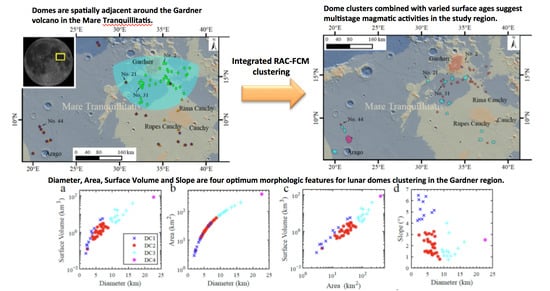Unsupervised Machine Learning on Domes in the Lunar Gardner Region: Implications for Dome Classification and Local Magmatic Activities on the Moon
Abstract
1. Introduction
2. Data and Methodology
2.1. Data
2.2. Dome Feature Extraction
2.2.1. Morphometric Features
2.2.2. Element Contents
2.2.3. Rheological Properties
2.3. Clustering Algorithm
3. Results
3.1. Morphometric, Spectral and Rheological Properties of Domes
3.2. Clusters of Domes
3.3. Verification of Clustering Results
3.4. Morphological and Rheological Properties of Selected Clusters
4. Discussion
4.1. Advantages of Using an Integrated Clustering Method for Classification
4.2. Multi-Stage Volcanic Activities Revealed by the Clustered Domes
5. Summary and Conclusions
Author Contributions
Funding
Institutional Review Board Statement
Informed Consent Statement
Data Availability Statement
Acknowledgments
Conflicts of Interest
Appendix A
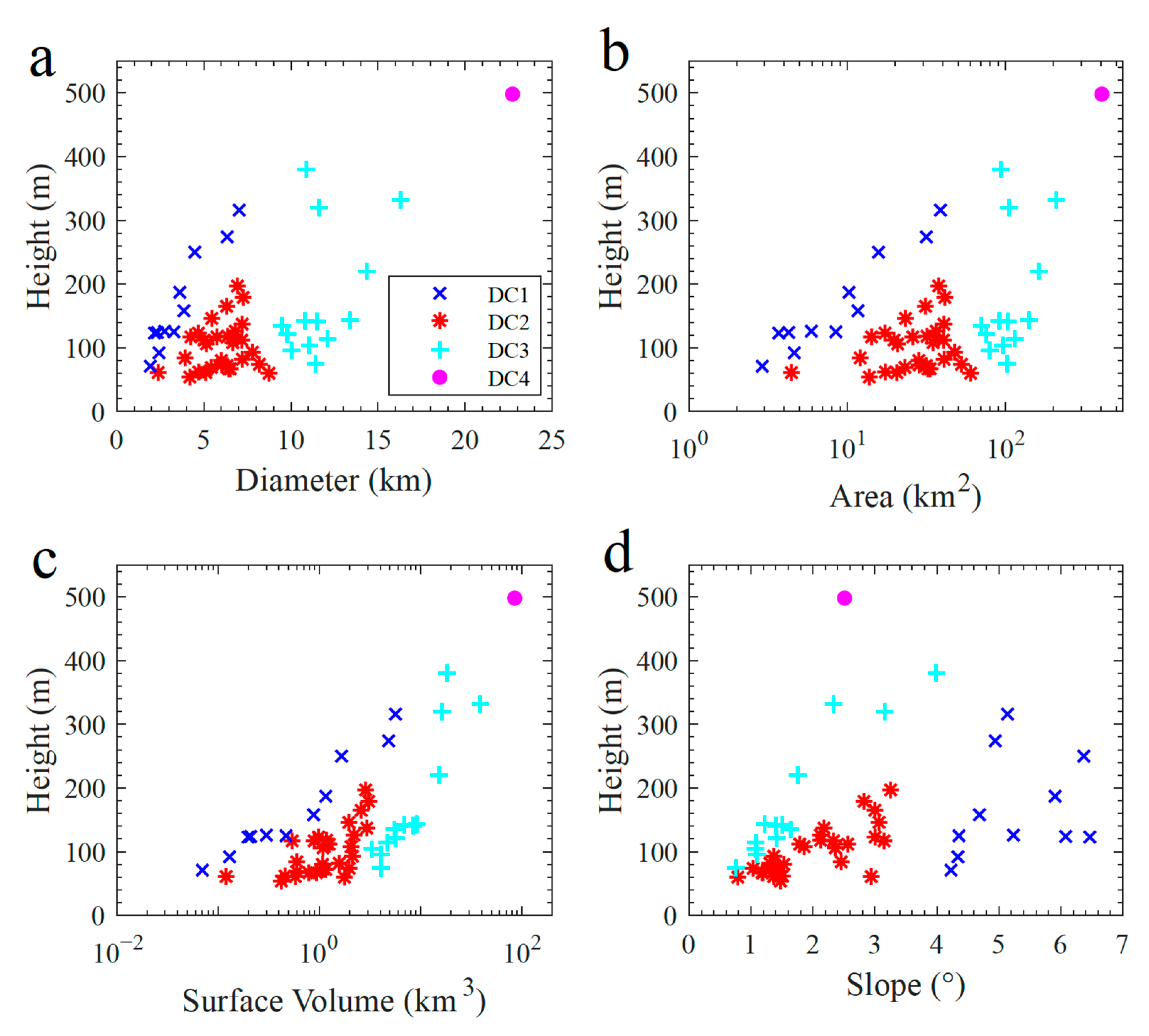
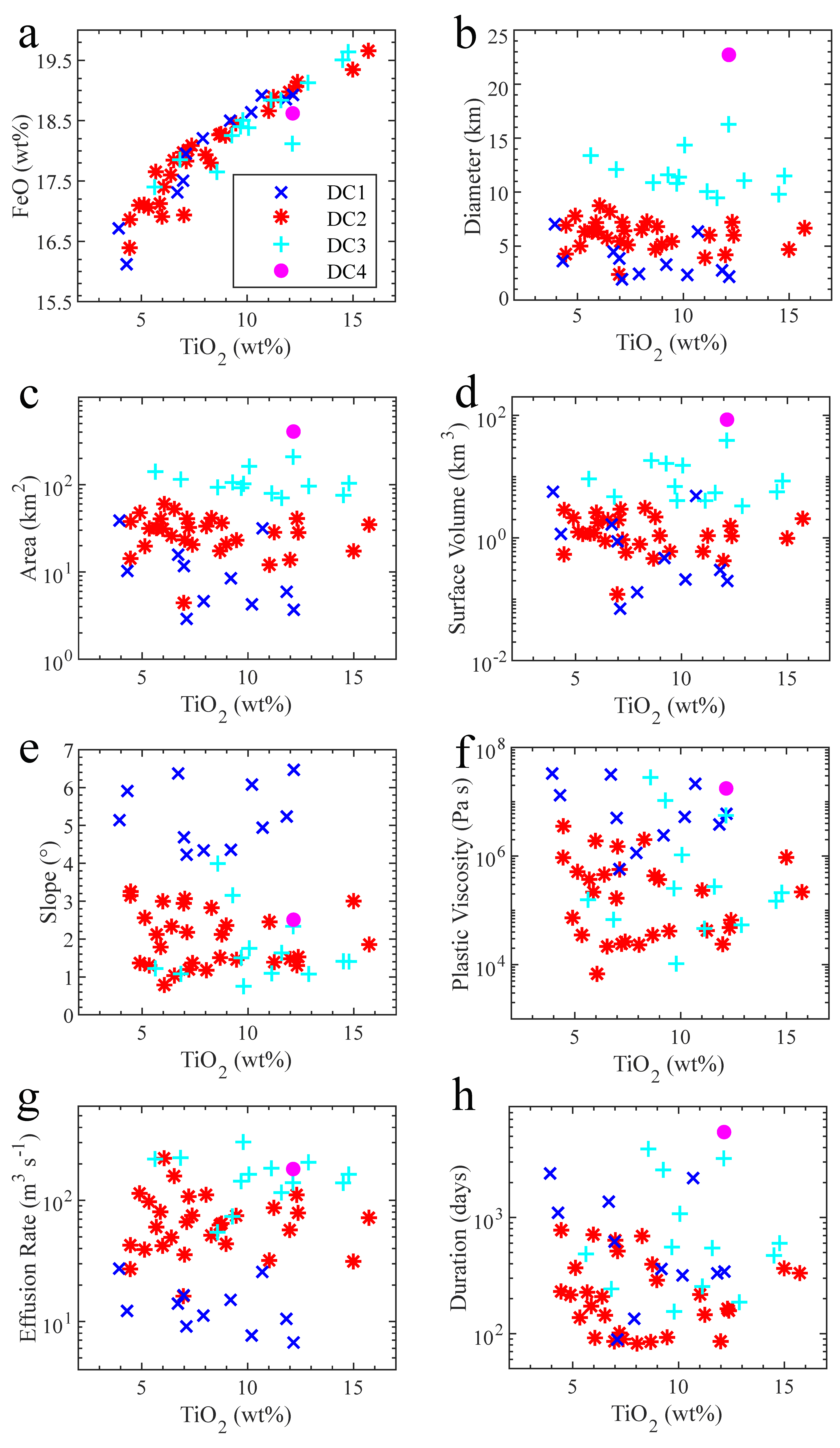
| Domes Identified in This Paper | Domes from Wöhler et al. [2] | Differences | |||||||||||
|---|---|---|---|---|---|---|---|---|---|---|---|---|---|
| No. | Lon. (°) | Lat. (°) | D (km) | H (m) | No.* | Lon. (°) | Lat. (°) | D (km) | H (m) | Lon. (°) | Lat. (°) | D (km) | H (m) |
| 21 | 30.75 | 14.34 | 10.89 | 380 | C8 | 30.72 | 14.40 | 12.50 | 270 | 0.03 | −0.06 | −1.61 | 110 |
| 25 | 35.89 | 14.21 | 7.20 | 137 | C7 | 35.86 | 14.18 | 8.50 | 110 | 0.03 | 0.03 | −1.30 | 27 |
| 40 | 27.46 | 18.98 | 2.75 | 126 | SC2 | 27.50 | 18.90 | 1.70 | 60 | −0.04 | 0.08 | 1.05 | 66 |
| 41 | 27.63 | 18.65 | 2.17 | 123 | SC1 | 27.60 | 18.60 | 2.30 | 72 | 0.03 | 0.05 | −0.13 | 51 |
| 42 | 31.92 | 10.71 | 7.21 | 82 | C6 | 31.97 | 10.76 | 7.70 | 50 | −0.05 | −0.05 | −0.49 | 32 |
| 43 | 33.04 | 10.54 | 9.46 | 135 | C5 | 33.02 | 10.56 | 11.10 | 100 | 0.02 | −0.02 | −1.64 | 35 |
| 44 | 20.77 | 9.26 | 6.66 | 108 | A6 | 20.79 | 9.22 | 9.50 | 50 | −0.02 | 0.04 | −2.84 | 58 |
| 45 | 20.92 | 8.96 | 9.81 | 121 | A5 | 20.96 | 8.88 | 8.40 | 45 | −0.04 | 0.08 | 1.41 | 76 |
| 46 | 21.25 | 8.55 | 11.49 | 141 | A4 | 21.27 | 8.65 | 11.10 | 65 | −0.02 | −0.10 | 0.39 | 76 |
| 47 | 36.95 | 8.50 | 10.05 | 96 | C4 | 36.78 | 8.85 | 13.30 | 50 | 0.17 | −0.35 | −3.25 | 46 |
| 48 | 22.05 | 7.71 | 4.69 | 123 | A1 | 21.96 | 7.66 | 5.60 | 45 | 0.09 | 0.05 | −0.91 | 78 |
| 49 | 21.60 | 7.55 | 22.72 | 498 | A2 | 21.70 | 7.56 | 25.40 | 330 | −0.10 | −0.01 | −2.68 | 168 |
| 50 | 36.78 | 7.51 | 11.61 | 320 | C3 | 36.73 | 7.58 | 17.00 | 190 | 0.05 | −0.07 | −5.39 | 130 |
| 51 | 34.48 | 7.24 | 4.19 | 54 | C9 | 34.66 | 7.06 | 13.30 | 15 | −0.18 | 0.18 | −9.11 | 39 |
| 52 | 38.32 | 7.23 | 10.81 | 142 | C2 | 38.32 | 7.23 | 12.20 | 125 | 0.00 | 0.00 | −1.39 | 17 |
| 53 | 37.62 | 7.13 | 6.00 | 80 | C1 | 37.48 | 7.11 | 8.10 | 25 | 0.14 | 0.02 | −2.10 | 55 |
| 54 | 19.97 | 6.13 | 16.28 | 332 | A3 | 20.07 | 6.24 | 23.60 | 270 | −0.10 | −0.11 | −7.32 | 62 |
| D (km) | A (km2) | H (m) | SV (km3) | Slope (°) | FeO (wt %) | TiO2 (wt %) | |
|---|---|---|---|---|---|---|---|
| D (km) | 1.00 | 0.95 | 0.78 | 0.58 | −0.45 | 0.13 | 0.22 |
| A (km2) | 0.95 | 1.00 | 0.92 | 0.65 | −0.28 | 0.14 | 0.24 |
| H (m) | 0.78 | 0.92 | 1.00 | 0.77 | −0.04 | 0.09 | 0.22 |
| SV (km3) | 0.58 | 0.65 | 0.77 | 1.00 | 0.38 | −0.13 | 0.03 |
| Slope (°) | −0.45 | −0.28 | −0.04 | 0.38 | 1.00 | −0.21 | −0.14 |
| FeO (wt %) | 0.13 | 0.14 | 0.09 | −0.13 | −0.21 | 1.00 | 0.94 |
| TiO2 (wt %) | 0.22 | 0.24 | 0.22 | 0.03 | −0.14 | 0.94 | 1.00 |
| D (km) | A (km2) | H (m) | SV (km3) | Slope (°) | FeO (wt %) | TiO2 (wt %) | |
|---|---|---|---|---|---|---|---|
| D (km) | 1.00 | 0.00 | 0.00 | 0.00 | 0.00 | 0.34 | 0.11 |
| A (km2) | 0.00 | 1.00 | 0.00 | 0.00 | 0.04 | 0.30 | 0.08 |
| H (m) | 0.00 | 0.00 | 1.00 | 0.00 | 0.76 | 0.50 | 0.11 |
| SV (km3) | 0.00 | 0.00 | 0.00 | 1.00 | 0.00 | 0.34 | 0.82 |
| Slope (°) | 0.00 | 0.04 | 0.76 | 0.00 | 1.00 | 0.12 | 0.33 |
| FeO (wt %) | 0.34 | 0.30 | 0.50 | 0.34 | 0.12 | 1.00 | 0.00 |
| TiO2 (wt %) | 0.11 | 0.08 | 0.11 | 0.82 | 0.33 | 0.00 | 1.00 |
References
- Lena, R.; Wöhler, C.; Phillips, J.; Chiocchetta, M.T. Lunar Domes: Properties and Formation Processes; Springer: Mailand, Italy, 2013. [Google Scholar]
- Wöhler, C.; Lena, R.; Lazzarotti, P.; Phillips, J.; Wirths, M.; Pujic, Z.; Geologic Lunar Research (GLR) Group. A combined spectrophotometric and morphometric study of the lunar mare dome fields near Cauchy, Arago, Hortensius, and Milichius. Icarus 2006, 183, 237–264. [Google Scholar] [CrossRef]
- Wöhler, C.; Lena, R.; Phillips, J. Formation of lunar mare domes along crustal fractures: Rheologic conditions, dimensions of feeder dikes, and the role of magma evolution. Icarus 2007, 189, 279–307. [Google Scholar] [CrossRef]
- Wöhler, C.; Lena, R. Lunar intrusive domes: Morphometric analysis and laccolith modelling. Icarus 2009, 204, 381–398. [Google Scholar] [CrossRef]
- Wilson, L.; Head, J.W. Generation, ascent and eruption of magma on the Moon: New insights into source depths, magma supply, intrusions and effusive/explosive eruptions (Part 1: Theory). Icarus 2017, 283, 146–175. [Google Scholar] [CrossRef]
- Head, J.W.; Gifford, A. Lunar mare domes: Classification and modes of origin. Moon Planets 1980, 22, 235. [Google Scholar] [CrossRef]
- Lena, R.; Wöhler, C.; Phillips, J.; Wirths, M.; Bregante, M.T. Lunar domes in the Doppelmayer region: Spectrophotometry, morphometry, rheology, and eruption conditions. Planet. Space Sci. 2007, 55, 1201–1217. [Google Scholar] [CrossRef]
- Lena, R.; Wöhler, C.; Bregante, M.T.; Lazzarotti, P.; Lammel, S. Lunar domes in Mare Undarum: Spectral and morphometric properties, eruption conditions, and mode of emplacement. Planet. Space Sci. 2008, 56, 553. [Google Scholar] [CrossRef]
- Zhao, J.N.; Xiao, L.; Qiao, L.; Glotch, T.D.; Huang, Q. The Mons Rumker volcanic complex of the Moon: A candidate landing site for the Chang’E-5 mission. J. Geophys. Res. Planets 2017, 122, 1419–1442. [Google Scholar] [CrossRef]
- Arya, A.S.; Rajasekhar, R.P.; Sur, K.; Krishna, B.G.; Suresh, K.; Srinivasan, T.P.; Iyer, K.V.; Chauhan, P.; Ajai; Kumar, A.S.K.; et al. Morphometric and rheological study of lunar domes of Marius Hills volcanic complex region using Chandrayaan-1 and recent datasets. J. Earth Syst. Sci. 2018, 127, 70. [Google Scholar] [CrossRef]
- Schnuriger, N.; Flahaut, J.; Martinot, M.; Chevrel, S.D. Long-lived volcanism expressed through mare infilling, domes and IMPs in the Arago region of the Moon. Planet. Space Sci. 2020, 185. [Google Scholar] [CrossRef]
- Whitford-Stark, J.L.; Head, J.W. The Procellarum volcanic complexes: Contrasting styles of volcanism. In Proceedings of the Lunar Planetary Science Conference, Houston, TX, USA, 1 January 1977; p. 2705. [Google Scholar]
- Weitz, C.M.; Head, J.W. Spectral properties of the Marius Hills volcanic complex and implications for the formation of lunar domes and cones. J. Geophys. Res. Planets 1999, 104, 18933–18956. [Google Scholar] [CrossRef]
- Baratoux, D.; Pinet, P.; Toplis, M.J.; Mangold, N.; Greeley, R.; Baptista, A.R.J.J.o.V.; Research, G. Shape, rheology and emplacement times of small martian shield volcanoes. J. Volcanol. Geotherm. Res. 2009, 185, 47–68. [Google Scholar] [CrossRef]
- Huang, Q.; Zhao, J.; Wang, X.; Wang, T.; Zhang, F.; Qiao, L.; Chen, Y.; Qiu, D.; Yang, Y.; Xiao, L. A large long-lived central-vent volcano in the Gardner region: Implications for the volcanic history of the nearside of the Moon. Earth Planet. Sci. Lett. 2020, 542, 116301. [Google Scholar] [CrossRef]
- Bezdek, J.C. Pattern Recognition with Fuzzy Objective Function Algorithms; Springer: Boston, MA, USA, 1981. [Google Scholar]
- Mok, P.Y.; Huang, H.Q.; Kwok, Y.L.; Au, J.S. A robust adaptive clustering analysis method for automatic identification of clusters. Pattern Recognit. 2012, 45, 3017–3033. [Google Scholar] [CrossRef]
- Wilson, L.; Head, J.W. Lunar Gruithuisen and Mairan domes: Rheology and mode of emplacement. J. Geophys. Res. Planets 2003, 108, 5012. [Google Scholar] [CrossRef]
- Haruyama, J.; Ohtake, M.; Matsunaga, T.; Morota, T.; Honda, C.; Yokota, Y.; Abe, M.; Ogawa, Y.; Miyamoto, H.; Iwasaki, A.; et al. Long-Lived Volcanism on the Lunar Farside Revealed by SELENE Terrain Camera. Science 2009, 323, 905–908. [Google Scholar] [CrossRef] [PubMed]
- Lucey, P.G.; Blewett, D.T.; Jolliff, B. Lunar iron and titanium abundance algorithms based on final processing of Clementine UVVIS data. J. Geophys. Res. Planets 2000, 105, 20297–20305. [Google Scholar] [CrossRef]
- Tye, A.R.; Head, J.W. Mare Tranquillitatis: Distribution of Mare Domes, Relation to Broad Mare Rise, and Evidence of a Previously Unrecognized Basin from LOLA Altimetric Data. In Proceedings of the Lunar and Planetary Science Conference XLIV, Houston, TX, USA, 1 March 2013. [Google Scholar]
- Lucey, P.G.; Taylor, G.J.; Malaret, E. Abundance and Distribution of Iron on the Moon. Science 1995, 268, 1150. [Google Scholar] [CrossRef]
- Lawrence, D.J.; Feldman, W.C.; Elphic, R.C.; Little, R.C.; Prettyman, T.H.; Maurice, S.; Lucey, P.G.; Binder, A.B. Iron abundances on the lunar surface as measured by the Lunar Prospector gamma-ray and neutron spectrometers. J. Geophys. Res. Planets 2002, 107, 13-11–13-26. [Google Scholar] [CrossRef]
- Jerde, E.A.; Snyder, G.A.; Taylor, L.A.; Liu, Y.G.; Schmitt, R.A. The origin and evolution of lunar high-Ti basalts: Periodic melting of a single source at Mare Tranquillitatis. Geochim. Et Cosmochim. Acta 1994, 58, 515–527. [Google Scholar] [CrossRef]
- Kodama, S.; Yamaguchi, Y. Lunar mare volcanism in the eastern nearside region derived from Clementine UV/VIS data. Meteorit. Planet. Sci. 2003, 38, 1461–1484. [Google Scholar] [CrossRef]
- Rajmon, D.; Spudis, P. Distribution and stratigraphy of basaltic units in Maria Tranquillitatis and Fecunditatis: A Clementine perspective. Meteorit. Planet. Sci. 2004, 39, 1699–1720. [Google Scholar] [CrossRef]
- Sato, H.; Robinson, M.S.; Lawrence, S.J.; Denevi, B.W.; Hapke, B.; Jolliff, B.L.; Hiesinger, H. Lunar mare TiO2 abundances estimated from UV/Vis reflectance. Icarus 2017, 296, 216–238. [Google Scholar] [CrossRef]
- Giguere, T.A.; Taylor, G.J.; Hawke, B.R.; Lucey, P.G. The titanium contents of lunar mare basalts. Meteorit. Planet. Sci. 2000, 35, 193–200. [Google Scholar] [CrossRef]
- Neal, C.R.; Taylor, L.A. Petrogenesis of mare basalts: A record of lunar volcanism. Geochim. Et Cosmochim. Acta 1992, 56, 2177–2211. [Google Scholar] [CrossRef]
- Grosse, P.; Kervyn, M. Morphometry of terrestrial shield volcanoes. Geomorphology 2018, 304, 1–14. [Google Scholar] [CrossRef]
- Halkidi, M.; Batistakis, Y.; Vazirgiannis, M. On clustering validation techniques. J. Intell. Inf. Syst. 2001, 17, 107–145. [Google Scholar] [CrossRef]
- Wang, Y.N.; Li, C.S.; Zuo, Y. A Selection Model for Optimal Fuzzy Clustering Algorithm and Number of Clusters Based on Competitive Comprehensive Fuzzy Evaluation. IEEE Trans. Fuzzy Syst. 2009, 17, 568–577. [Google Scholar] [CrossRef]
- Yang, M.S.; Nataliani, Y. Robust-learning fuzzy c-means clustering algorithm with unknown number of clusters. Pattern Recognit. 2017, 71, 45–59. [Google Scholar] [CrossRef]
- Bezdek, J.C.; Ehrlich, R.; Full, W. FCM: The fuzzy c-means clustering algorithm. Comput. Geosci. 1984, 10, 191–203. [Google Scholar] [CrossRef]
- Pakhira, M.K.; Bandyopadhyay, S.; Maulik, U. A study of some fuzzy cluster validity indices, genetic clustering and application to pixel classification. Fuzzy Sets Syst. 2005, 155, 191–214. [Google Scholar] [CrossRef]
- Press, W.H.; Teukolsky, S.A.; Vetterling, W.T.; Flannery, B.P. Numerical Recipes in C, 2nd ed.; Cambridge University Press: Cambridge, UK; New York, NY, USA, 1992. [Google Scholar]
- Hiesinger, H.; Jaumann, R.; Neukum, G.; Head, J.W. Ages of mare basalts on the lunar nearside. J. Geophys. Res. Planets 2000, 105, 29239–29275. [Google Scholar] [CrossRef]
- Urbanowicz, R.J.; Meeker, M.; La Cava, W.; Olson, R.S.; Moore, J.H. Relief-based feature selection: Introduction and review. J. Biomed. Inform. 2018, 85, 189–203. [Google Scholar] [CrossRef] [PubMed]
- Guyon, I.; Elisseeff, A. An introduction to variable and feature selection. J. Mach. Learn. Res. 2003, 3, 1157–1182. [Google Scholar] [CrossRef]
- Wieczorek, M.A.; Neumann, G.A.; Nimmo, F.; Kiefer, W.S.; Taylor, G.J.; Melosh, H.J.; Phillips, R.J.; Solomon, S.C.; Andrews-Hanna, J.C.; Asmar, S.W.; et al. The Crust of the Moon as Seen by GRAIL. Science 2013, 339, 671–675. [Google Scholar] [CrossRef]
- Wilhelms, D.E. Geologic Map of the Taruntius Quadrangle of the Moon; Technical Report; U.S. Geol. Survey Map I-722: Washington, DC, USA, 1972.
- Ernst, R.; Grosfils, E.; Mège, D. Giant Dike Swarms: Earth, Venus, and Mars. Annu. Rev. Earth Planet. Sci. 2001, 29, 489–534. [Google Scholar] [CrossRef]
- Andrews-Hanna, J.C.; Besserer, J.; Head Iii, J.W.; Howett, C.J.A.; Kiefer, W.S.; Lucey, P.J.; McGovern, P.J.; Melosh, H.J.; Neumann, G.A.; Phillips, R.J.; et al. Structure and evolution of the lunar Procellarum region as revealed by GRAIL gravity data. Nature 2014, 514, 68–71. [Google Scholar] [CrossRef] [PubMed]
- Michaut, C.; Pinel, V. Magma Ascent and Eruption Triggered by Cratering on the Moon. Geophys. Res. Lett. 2018, 45, 6408–6416. [Google Scholar] [CrossRef]
- Galgana, G.A.; McGovern, P.J.; Grosfils, E.B. Evolution of large Venusian volcanoes: Insights from coupled models of lithospheric flexure and magma reservoir pressurization. J. Geophys. Res. Planets 2011, 116. [Google Scholar] [CrossRef]

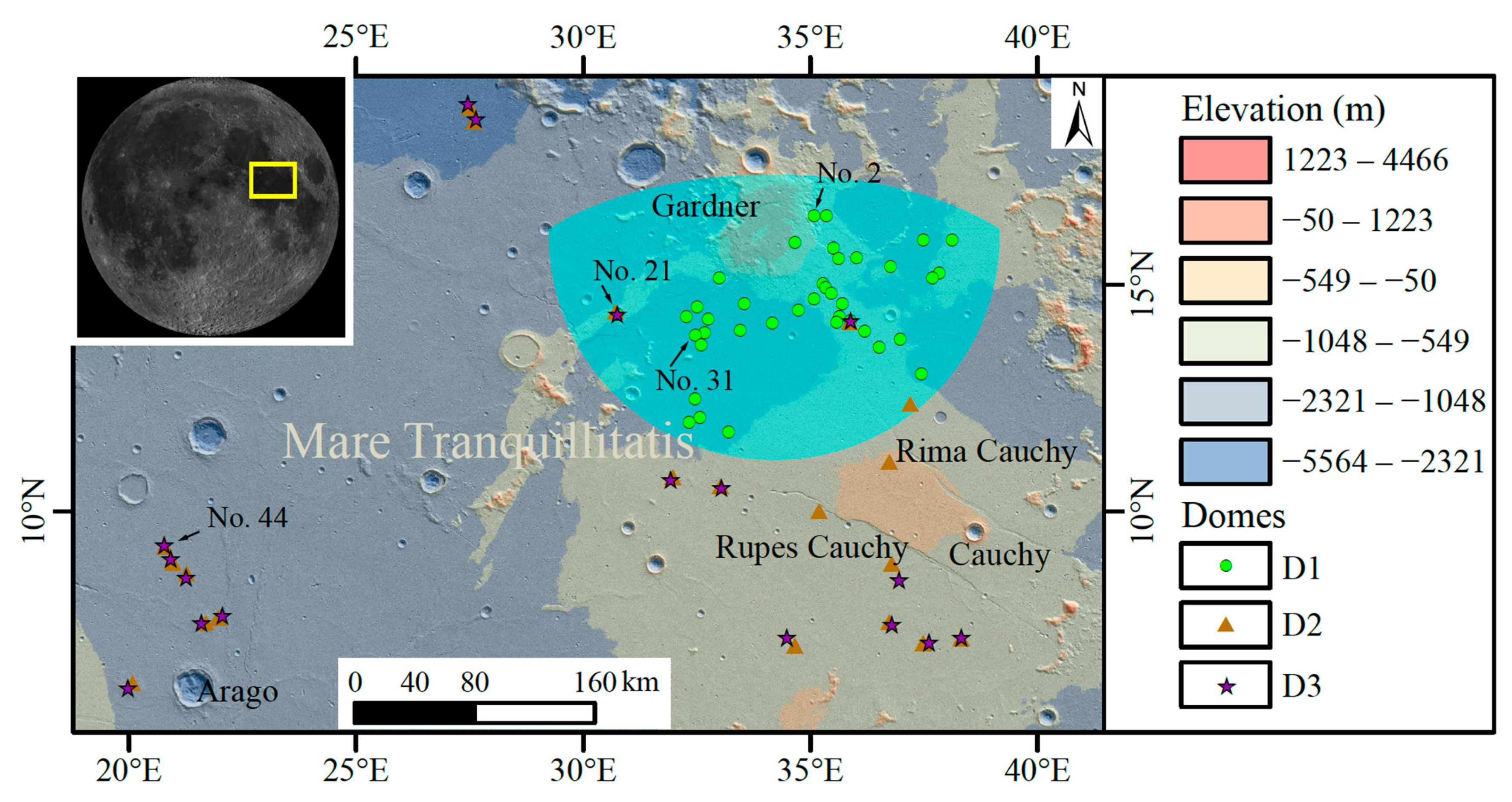
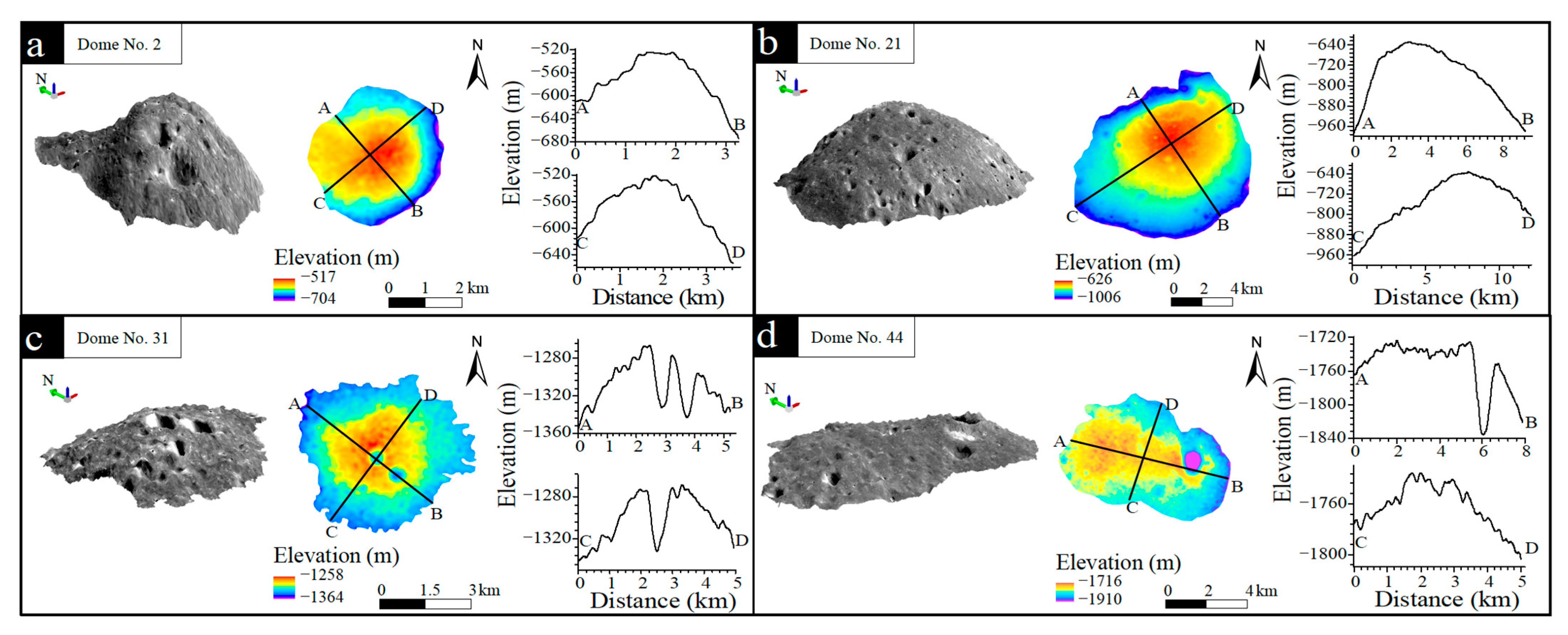
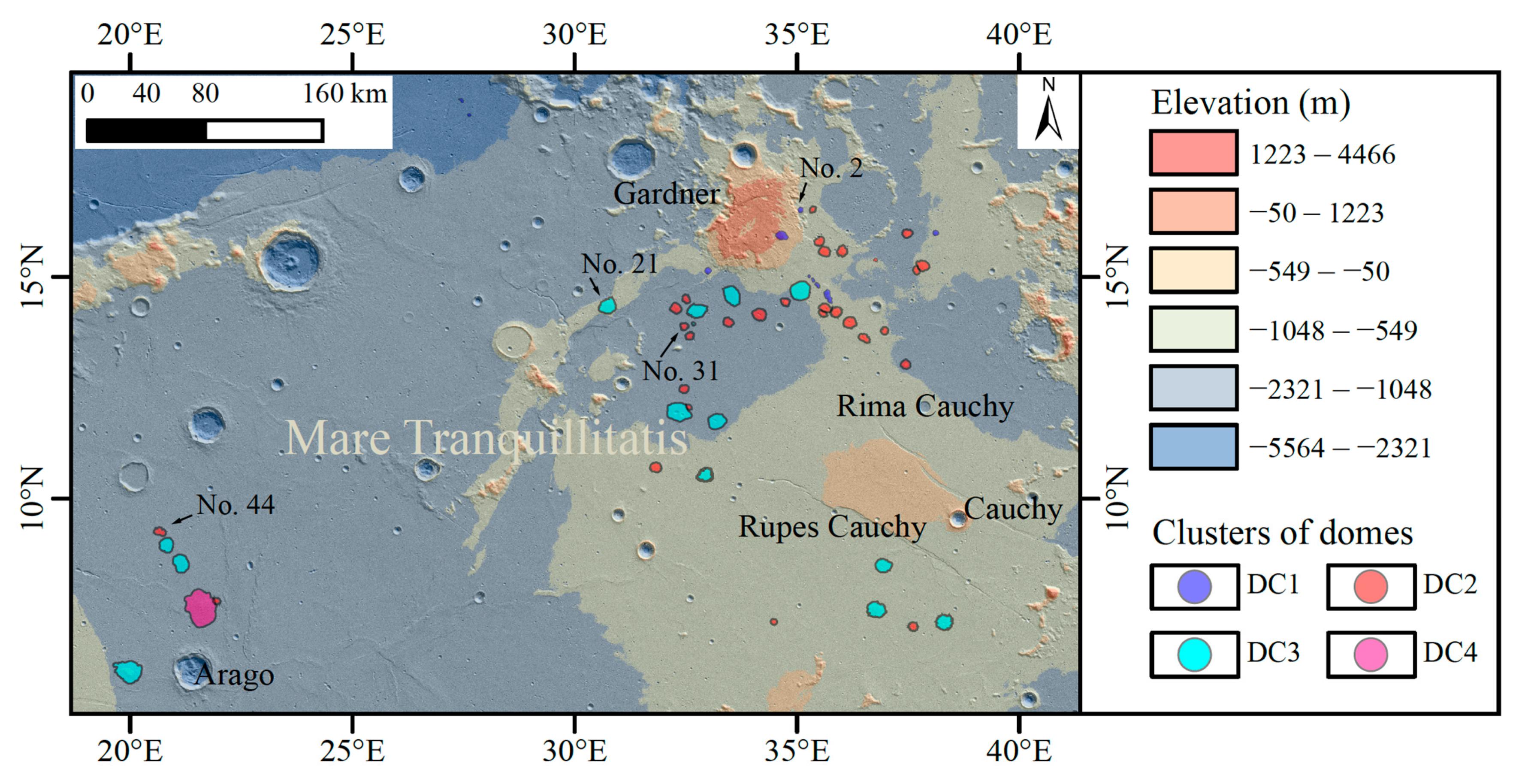
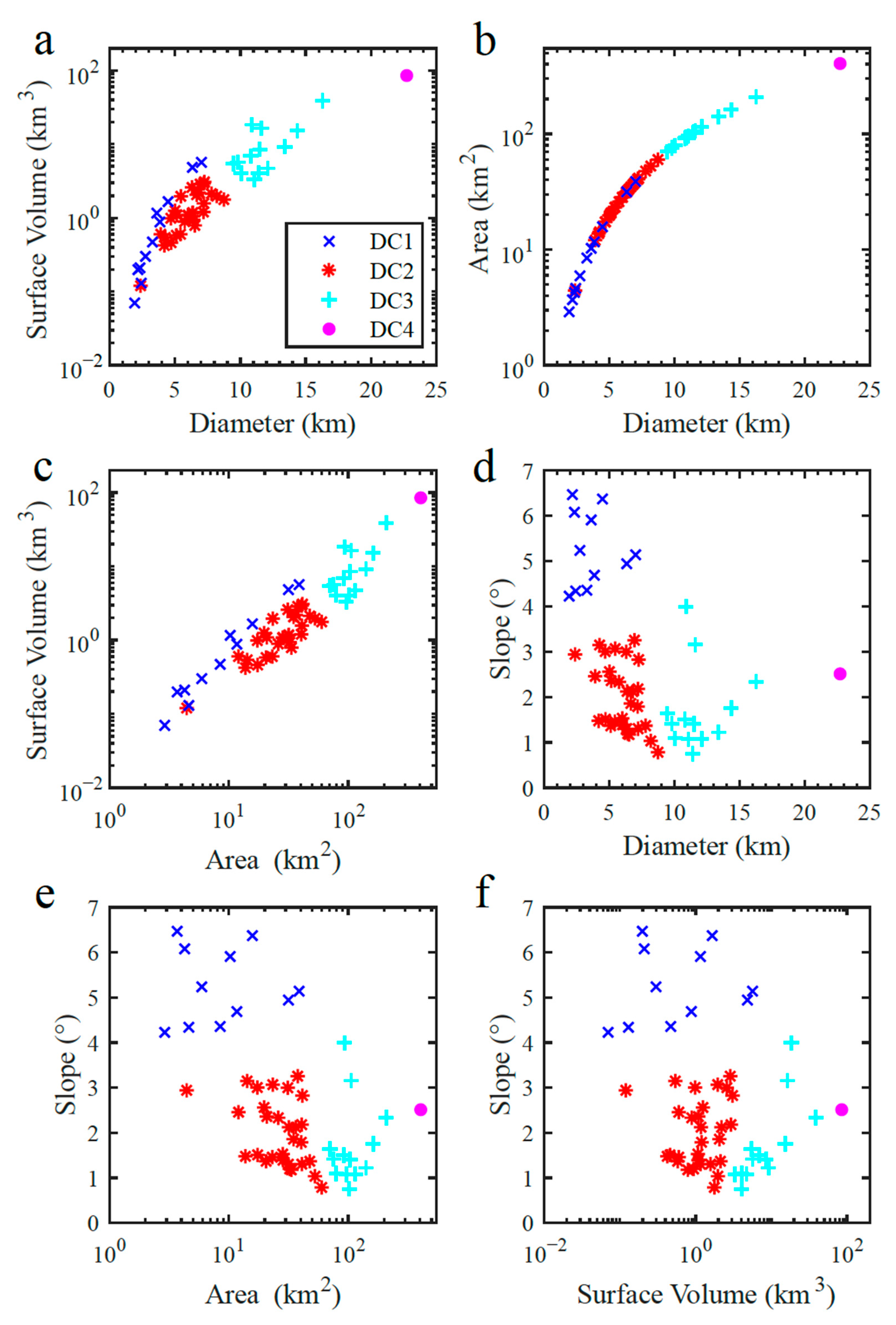
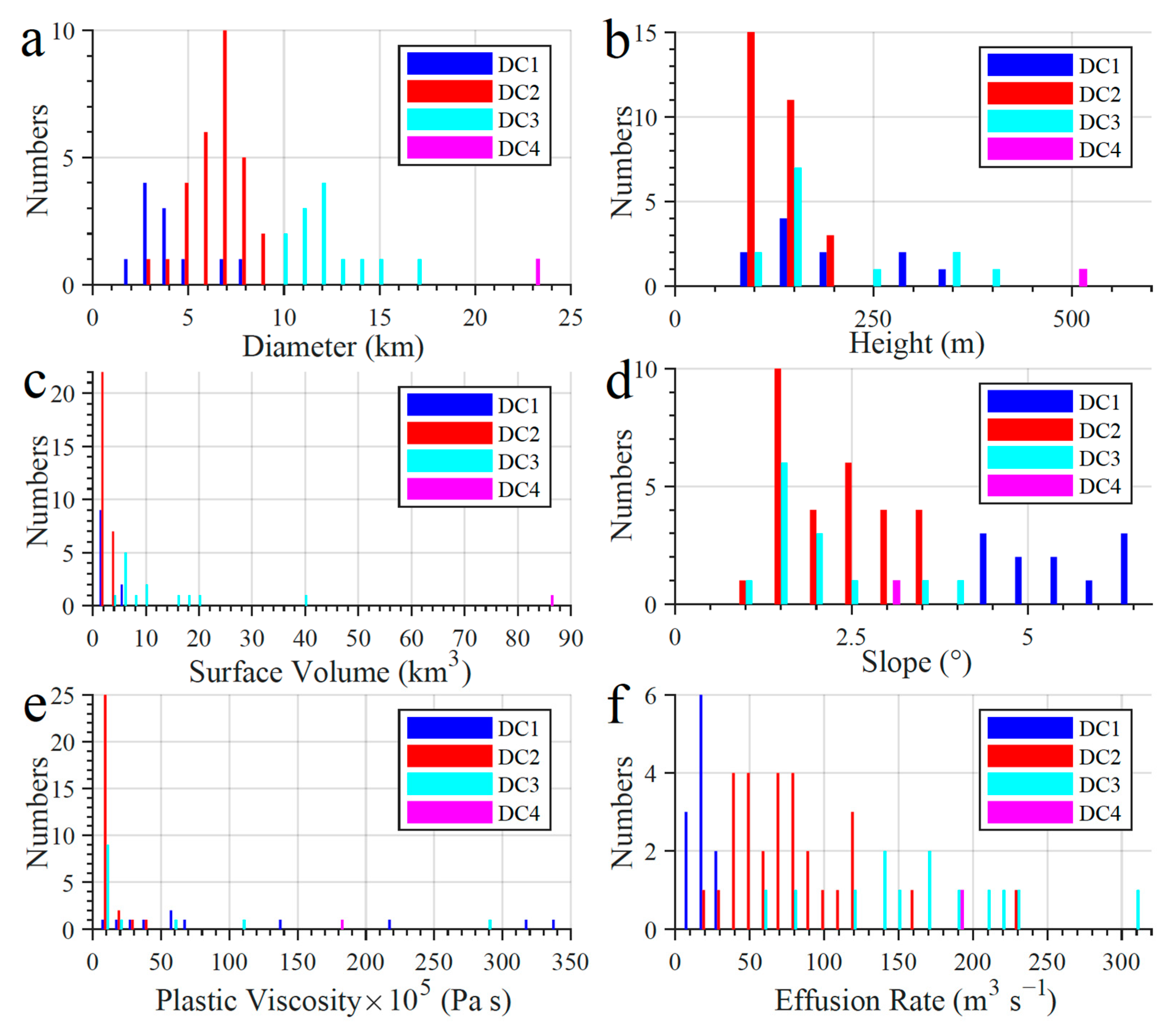
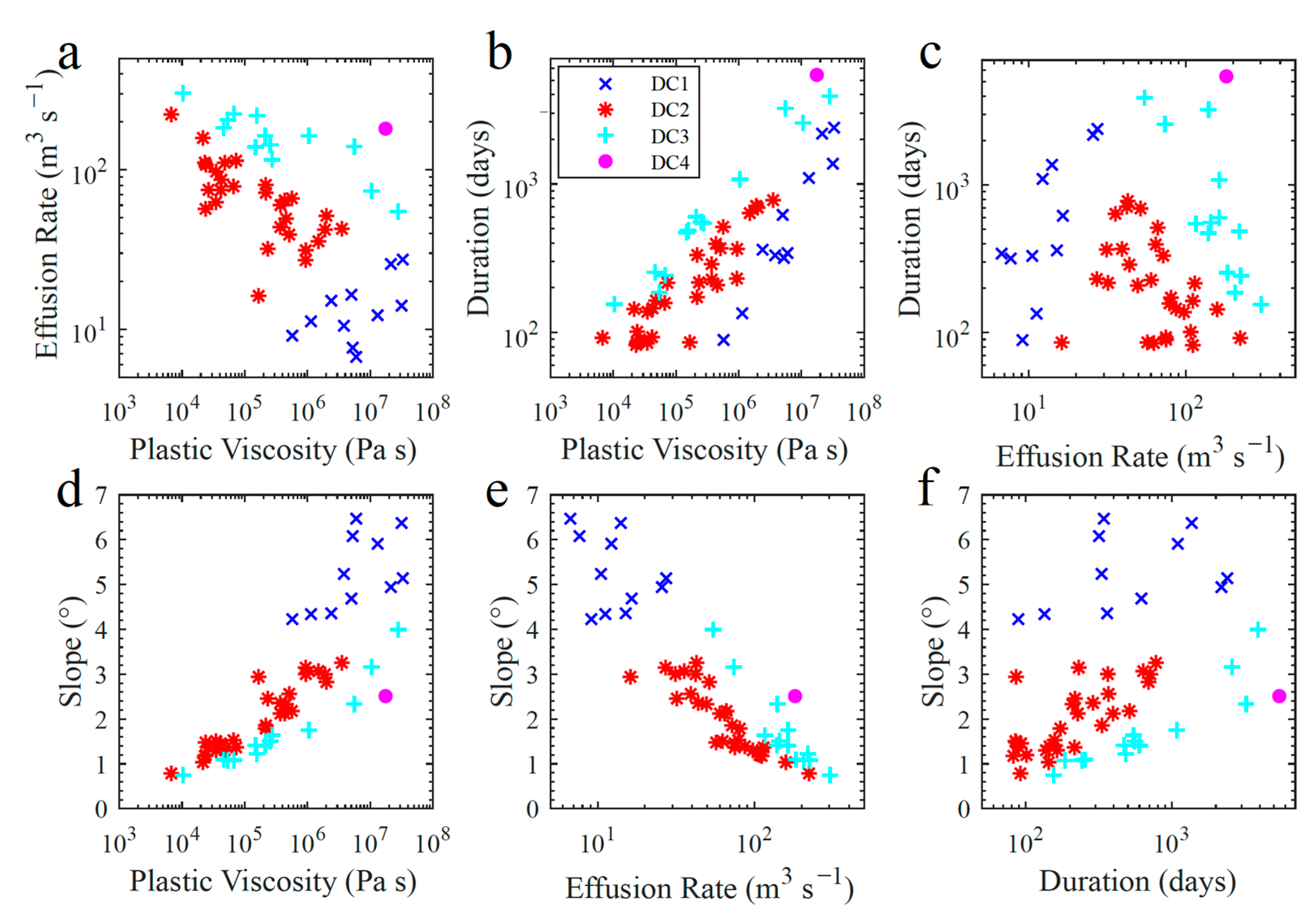
| No. | Lon. (°) | Lat. (°) | A (km2) | SV (km3) | H (m) | D (km) | Slope (°) | FeO (wt.%) | TiO2 (wt.%) | τ | η (Pa s) | E (m3 s−1) | Te (days) | Volcanic Pit/Fissure | DC |
|---|---|---|---|---|---|---|---|---|---|---|---|---|---|---|---|
| 1 | 35.36 | 16.52 | 14.23 | 0.54 | 117 | 4.26 | 3.15 | 16.39 | 4.45 | 6.77 × 103 | 9.38 × 105 | 27.10 | 230.63 | Yes | DC2 |
| 2 | 35.09 | 16.51 | 10.26 | 1.16 | 187 | 3.61 | 5.91 | 16.12 | 4.31 | 2.04 × 104 | 1.32 × 107 | 12.23 | 1098.22 | No | DC1 |
| 3 | 38.12 | 15.99 | 11.67 | 0.88 | 158 | 3.85 | 4.69 | 17.51 | 6.98 | 1.36 × 104 | 5.03 × 106 | 16.46 | 618.88 | Yes | DC1 |
| 4 | 37.48 | 15.98 | 31.52 | 1.16 | 72 | 6.34 | 1.30 | 17.06 | 5.34 | 1.72 × 103 | 3.51 × 104 | 97.54 | 137.64 | No | DC2 |
| 5 | 34.66 | 15.93 | 38.78 | 5.66 | 316 | 7.03 | 5.14 | 16.72 | 3.93 | 2.99 × 104 | 3.32 × 107 | 27.34 | 2395.71 | Yes | DC1 |
| 6 | 35.51 | 15.80 | 31.19 | 2.59 | 165 | 6.30 | 3.00 | 16.91 | 5.98 | 9.10 × 103 | 1.90 × 106 | 42.12 | 711.72 | Yes | DC2 |
| 7 | 36.02 | 15.58 | 37.73 | 2.87 | 197 | 6.93 | 3.25 | 16.86 | 4.46 | 1.18 × 104 | 3.55 × 106 | 42.67 | 778.39 | No | DC2 |
| 8 | 35.62 | 15.57 | 40.46 | 1.20 | 112 | 7.18 | 1.79 | 17.12 | 5.87 | 3.68 × 103 | 2.17 × 105 | 80.49 | 172.55 | No | DC2 |
| 9 | 36.77 | 15.38 | 4.43 | 0.12 | 61 | 2.37 | 2.94 | 17.97 | 6.97 | 3.30 × 103 | 1.67 × 105 | 16.18 | 85.83 | No | DC2 |
| 10 | 37.83 | 15.25 | 47.68 | 2.13 | 93 | 7.79 | 1.37 | 17.10 | 4.89 | 2.34 × 103 | 7.30 × 104 | 114.24 | 215.81 | No | DC2 |
| 11 | 33.00 | 15.14 | 15.75 | 1.66 | 250 | 4.48 | 6.37 | 17.31 | 6.70 | 2.94 × 104 | 3.18 × 107 | 14.04 | 1368.69 | No | DC1 |
| 12 | 37.69 | 15.14 | 19.72 | 1.25 | 112 | 5.01 | 2.56 | 17.11 | 5.13 | 5.27 × 103 | 5.14 × 105 | 39.23 | 368.77 | Yes | DC2 |
| 13 | 35.28 | 15.02 | 2.90 | 0.07 | 71 | 1.92 | 4.23 | 17.95 | 7.10 | 5.52 × 103 | 5.75 × 105 | 9.10 | 89.02 | No | DC1 |
| 14 | 35.34 | 14.93 | 4.62 | 0.13 | 92 | 2.43 | 4.34 | 18.21 | 7.91 | 7.35 × 103 | 1.14 × 106 | 11.19 | 134.47 | No | DC1 |
| 15 | 35.46 | 14.82 | 8.46 | 0.47 | 125 | 3.28 | 4.36 | 18.50 | 9.19 | 1.00 × 104 | 2.40 × 106 | 15.08 | 360.73 | No | DC1 |
| 16 | 35.08 | 14.69 | 140.86 | 9.20 | 143 | 13.39 | 1.22 | 17.40 | 5.63 | 3.22 × 103 | 1.57 × 105 | 219.48 | 485.15 | No | DC3 |
| 17 | 33.54 | 14.58 | 114.86 | 4.71 | 114 | 12.09 | 1.08 | 17.85 | 6.83 | 2.26 × 103 | 6.75 × 104 | 224.50 | 242.82 | No | DC3 |
| 18 | 35.70 | 14.57 | 31.55 | 4.84 | 274 | 6.34 | 4.94 | 18.92 | 10.69 | 2.49 × 104 | 2.14 × 107 | 25.66 | 2183.40 | No | DC1 |
| 19 | 32.51 | 14.50 | 23.33 | 1.96 | 146 | 5.45 | 3.07 | 16.94 | 7.02 | 8.24 × 103 | 1.50 × 106 | 35.60 | 637.14 | Yes | DC2 |
| 20 | 34.74 | 14.44 | 25.94 | 0.89 | 117 | 5.75 | 2.33 | 17.60 | 6.39 | 5.02 × 103 | 4.56 × 105 | 49.40 | 208.52 | No | DC2 |
| 21 | 30.75 | 14.34 | 93.08 | 18.36 | 380 | 10.89 | 3.99 | 17.65 | 8.57 | 2.79 × 104 | 2.81 × 107 | 54.58 | 3893.46 | No | DC3 |
| 22 | 35.64 | 14.30 | 36.40 | 2.20 | 126 | 6.81 | 2.12 | 18.28 | 8.76 | 4.91 × 103 | 4.34 × 105 | 64.37 | 395.58 | Yes | DC2 |
| 23 | 32.28 | 14.29 | 41.35 | 3.08 | 179 | 7.26 | 2.82 | 17.80 | 8.28 | 9.30 × 103 | 2.01 × 106 | 51.47 | 692.57 | No | DC2 |
| 24 | 32.76 | 14.24 | 96.17 | 3.32 | 104 | 11.07 | 1.08 | 19.13 | 12.87 | 2.06 × 103 | 5.38 × 104 | 206.04 | 186.50 | No | DC3 |
| 25 | 35.89 | 14.21 | 40.74 | 2.94 | 137 | 7.20 | 2.18 | 17.83 | 7.12 | 5.49 × 103 | 5.66 × 105 | 66.26 | 513.55 | Yes | DC2 |
| 26 | 35.58 | 14.17 | 17.42 | 0.46 | 62 | 4.71 | 1.51 | 18.27 | 8.68 | 1.72 × 103 | 3.49 × 104 | 62.60 | 85.04 | No | DC2 |
| 27 | 34.16 | 14.15 | 59.98 | 1.77 | 60 | 8.74 | 0.79 | 17.40 | 6.05 | 8.68 × 102 | 6.76 × 103 | 222.74 | 91.97 | Yes | DC2 |
| 28 | 33.46 | 13.98 | 33.40 | 0.79 | 67 | 6.52 | 1.18 | 17.93 | 8.04 | 1.45 × 103 | 2.32 × 104 | 111.08 | 82.32 | Yes | DC2 |
| 29 | 36.19 | 13.97 | 52.68 | 1.97 | 74 | 8.19 | 1.04 | 17.85 | 6.53 | 1.41 × 103 | 2.16 × 104 | 158.62 | 143.74 | No | DC2 |
| 30 | 32.68 | 13.94 | 4.26 | 0.21 | 124 | 2.33 | 6.08 | 18.64 | 10.19 | 1.39 × 104 | 5.27 × 106 | 7.65 | 317.52 | No | DC1 |
| 31 | 32.47 | 13.88 | 20.80 | 1.09 | 106 | 5.15 | 2.36 | 18.25 | 8.98 | 4.60 × 103 | 3.70 × 105 | 43.72 | 288.54 | Yes | DC2 |
| 32 | 36.97 | 13.79 | 20.51 | 0.58 | 61 | 5.11 | 1.37 | 18.09 | 7.38 | 1.53 × 103 | 2.65 × 104 | 74.93 | 89.59 | No | DC2 |
| 33 | 32.59 | 13.67 | 23.12 | 0.60 | 69 | 5.43 | 1.46 | 18.45 | 9.46 | 1.85 × 103 | 4.15 × 104 | 74.66 | 93.01 | No | DC2 |
| 34 | 36.52 | 13.62 | 31.84 | 1.18 | 118 | 6.37 | 2.12 | 17.65 | 5.68 | 4.60 × 103 | 3.71 × 105 | 60.13 | 227.14 | Yes | DC2 |
| 35 | 37.45 | 13.03 | 32.34 | 0.94 | 67 | 6.42 | 1.20 | 18.02 | 7.21 | 1.47 × 103 | 2.41 × 104 | 107.55 | 101.16 | No | DC2 |
| 36 | 32.46 | 12.48 | 28.42 | 1.09 | 73 | 6.02 | 1.39 | 18.89 | 11.24 | 1.87 × 103 | 4.25 × 104 | 86.75 | 145.43 | No | DC2 |
| 37 | 32.57 | 12.07 | 12.05 | 0.60 | 84 | 3.92 | 2.46 | 18.66 | 11.02 | 3.79 × 103 | 2.33 × 105 | 31.96 | 217.26 | No | DC2 |
| 38 | 32.34 | 11.96 | 161.75 | 15.25 | 220 | 14.35 | 1.76 | 18.38 | 10.06 | 7.10 × 103 | 1.05 × 106 | 163.82 | 1077.43 | No | DC3 |
| 39 | 33.20 | 11.75 | 102.04 | 4.06 | 75 | 11.40 | 0.75 | 18.51 | 9.79 | 1.04 × 103 | 1.04 × 104 | 303.19 | 154.99 | No | DC3 |
| 40 | 27.46 | 18.98 | 5.93 | 0.30 | 126 | 2.75 | 5.24 | 18.85 | 11.83 | 1.22 × 104 | 3.82 × 106 | 10.50 | 330.73 | Yes | DC1 |
| 41 | 27.63 | 18.65 | 3.69 | 0.20 | 123 | 2.17 | 6.47 | 18.93 | 12.17 | 1.47 × 104 | 6.00 × 106 | 6.70 | 342.55 | Yes | DC1 |
| 42 | 31.92 | 10.71 | 40.86 | 1.57 | 82 | 7.21 | 1.30 | 19.07 | 12.31 | 1.96 × 103 | 4.80 × 104 | 110.94 | 163.94 | Yes | DC2 |
| 43 | 33.04 | 10.54 | 70.34 | 5.47 | 135 | 9.46 | 1.63 | 18.84 | 11.59 | 4.06 × 103 | 2.74 × 105 | 116.01 | 545.74 | Yes | DC3 |
| 44 | 20.77 | 9.26 | 34.83 | 2.06 | 108 | 6.66 | 1.86 | 19.66 | 15.73 | 3.69 × 103 | 2.18 × 105 | 71.87 | 332.23 | No | DC2 |
| 45 | 20.92 | 8.96 | 75.59 | 5.67 | 121 | 9.81 | 1.41 | 19.51 | 14.51 | 3.14 × 103 | 1.49 × 105 | 139.18 | 471.24 | No | DC3 |
| 46 | 21.25 | 8.55 | 103.65 | 8.50 | 141 | 11.49 | 1.41 | 19.64 | 14.77 | 3.64 × 103 | 2.12 × 105 | 163.85 | 600.62 | No | DC3 |
| 47 | 36.95 | 8.50 | 79.41 | 4.05 | 96 | 10.05 | 1.09 | 18.84 | 11.12 | 1.93 × 103 | 4.61 × 104 | 184.12 | 254.84 | Yes | DC3 |
| 48 | 22.05 | 7.71 | 17.30 | 0.99 | 123 | 4.69 | 3.00 | 19.35 | 14.99 | 6.79 × 103 | 9.44 × 105 | 31.30 | 364.98 | Yes | DC2 |
| 49 | 21.60 | 7.55 | 405.44 | 85.19 | 498 | 22.72 | 2.51 | 18.62 | 12.15 | 2.30 × 104 | 1.76 × 107 | 181.40 | 5435.81 | No | DC4 |
| 50 | 36.78 | 7.51 | 105.85 | 16.38 | 320 | 11.61 | 3.16 | 18.25 | 9.28 | 1.86 × 104 | 1.06 × 107 | 73.71 | 2572.00 | No | DC3 |
| 51 | 34.48 | 7.24 | 13.77 | 0.42 | 54 | 4.19 | 1.48 | 18.98 | 11.99 | 1.47 × 103 | 2.38 × 104 | 56.89 | 85.90 | No | DC2 |
| 52 | 38.32 | 7.23 | 91.74 | 6.92 | 142 | 10.81 | 1.50 | 18.40 | 9.69 | 3.93 × 103 | 2.54 × 105 | 144.01 | 556.30 | No | DC3 |
| 53 | 37.62 | 7.13 | 28.27 | 1.07 | 80 | 6.00 | 1.53 | 19.14 | 12.38 | 2.25 × 103 | 6.63 × 104 | 78.75 | 157.77 | Yes | DC2 |
| 54 | 19.97 | 6.13 | 208.14 | 38.94 | 332 | 16.28 | 2.34 | 18.12 | 12.14 | 1.43 × 104 | 5.60 × 106 | 139.70 | 3226.18 | No | DC3 |
| Feature Group a | C1 (no.) | C2 (no.) | C3 (no.) | C4 (no.) | |
|---|---|---|---|---|---|
| 1, 2 | 2 | 16 17 21 24 38 39 43 45 46 47 49 50 52 54 | the rest (40) | \ | \ |
| 1, 3 | 3 | 49 | 16 17 21 24 38 39 43 45 46 47 50 52 54 | the rest (40) | \ |
| 1, 5 | 2 | 2 3 5 11 13 14 15 18 30 40 41 | the rest (43) | \ | \ |
| 2, 3 | 4 | 49 54 | 39 52 | 16 17 21 38 46 50 | the rest (44) |
| 3, 5 | 2 | 4 8 10 16 17 24 26 27 28 29 32 33 35 36 38 39 42 43 44 45 46 47 51 52 53 | the rest (29) | \ | \ |
| 3, 6 | 3 | 1 2 4 5 6 7 8 10 11 12 16 19 27 | 3 9 13 14 17 20 21 22 23 25 26 28 29 31 32 34 35 | the rest (24) | \ |
| 4, 6 | 2 | 5 11 18 21 49 50 54 | the rest (47) | \ | \ |
| 1, 2, 3 | 2 | 49 | the rest (53) | \ | \ |
| 1, 2, 5 | 3 | 49 | 2 3 5 11 13 14 15 18 30 40 41 | the rest (42) | \ |
| 1, 2, 6 | 3 | 49 | 16 17 21 24 38 39 43 45 46 47 50 52 54 | the rest (40) | \ |
| 1, 3, 4 | 2 | 5 7 11 16 17 18 21 23 24 38 39 43 45 46 47 49 50 52 54 | the rest (35) | \ | \ |
| 1, 4, 6 | 2 | 21 38 49 50 54 | the rest (49) | \ | \ |
| 2, 3, 4 | 2/3 | 49 | the rest (53) | \ | \ |
| 49 | 5 21 38 50 54 | the rest (48) | \ | ||
| 2, 4, 6 | 2 | 21 38 49 50 54 | the rest (49) | \ | \ |
| 3, 4, 6 | 2 | 49 | the rest (53) | \ | \ |
| 3, 5, 7 | 2 | 11 15 18 30 40 41 | the rest (48) | \ | \ |
| 4, 5, 6 | 2 | 2 3 5 11 13 14 15 18 21 30 40 41 49 50 54 | the rest (39) | \ | \ |
| 1, 2, 3, 5 * | 4 | 49 | 2 3 5 11 13 14 15 18 30 40 41 | 16 17 21 24 38 39 43 45 46 47 50 52 54 | the rest (29) |
| 1, 2, 3, 6 | 3 | 49 | 16 17 21 24 38 39 43 45 46 47 50 52 54 | the rest (40) | \ |
| 1, 4, 6, 7 | 2 | 21 38 49 50 54 | the rest (49) | \ | \ |
| 2, 3, 4, 5 | 3 | 49 | 16 17 24 38 39 43 45 46 47 52 | the rest (43) | \ |
| 2, 3, 4, 7 | 3 | 49 | 18 21 38 50 54 | the rest (48) | \ |
| 2, 3, 6, 7 | 2 | 49 | the rest (53) | \ | \ |
| 2, 4, 6, 7 | 2 | 21 38 49 50 54 | the rest (49) | \ | \ |
| 1, 2, 3, 4, 7 | 2 | 49 | the rest (53) | \ | \ |
| 2, 3, 4, 5, 6, 7 | 2 | 49 | the rest (53) | \ | \ |
| D (km) | A (km2) | H (m) | SV (km3) | Slope (°) | Ratio a | FeO (wt %) | TiO2 (wt %) | η (Pa s) | E (m3 s−1) | Te (days) | Rise Speed (m s−1) | Dike Width (m) | Dike Length (km) | Model Age (Ga) [37] | Model Age (Ga) [11] | Model Age (Ga) [15] | |
|---|---|---|---|---|---|---|---|---|---|---|---|---|---|---|---|---|---|
| DC1 | 1.92–7.03 | 2.90–38.78 | 71–316 | 0.07–5.66 | 4.23–6.47 | 4/11 | 16.12–18.93 | 3.93–12.17 | 5.75 × 105–3.32 × 107 | 6.70–27.34 | 89.02–2395.71 | 6.94 × 10−7–2.89 × 10−5 | 33.8–176.78 | 130.58 | \ | / | |
| DC2 | 2.37–8.74 | 4.43–59.98 | 54–197 | 0.12–3.08 | 0.79–3.25 | 12/29 | 16.39–19.66 | 4.45–15.73 | 6.76 × 103–3.55 × 106 | 16.18–222.74 | 82.32–778.39 | 5.43 × 10−7–1.72 × 10−3 | 5.52–71.02 | 24.46–157.44 | / | ||
| DC3 | 9.46–16.28 | 70.34–208.14 | 75–380 | 3.32–38.94 | 0.75–3.99 | 1/13 | 17.40–19.64 | 5.63–14.77 | 1.04 × 104–2.81 × 107 | 54.58–303.15 | 155.01–3893.46 | 8.08 × 10−7–1.16 × 10−3 | 6.58–165.24 | 28.80–98.76 | \ | ||
| DC4 | 22.72 | 405.44 | 498 | 85.19 | 2.51 | 0/1 | 18.62 | 12.15 | 1.76 × 107 | 181.4 | 5435.81 | 1.24 × 10−6 | 136.53 | \ | \ |
Publisher’s Note: MDPI stays neutral with regard to jurisdictional claims in published maps and institutional affiliations. |
© 2021 by the authors. Licensee MDPI, Basel, Switzerland. This article is an open access article distributed under the terms and conditions of the Creative Commons Attribution (CC BY) license (http://creativecommons.org/licenses/by/4.0/).
Share and Cite
Chen, Y.; Huang, Q.; Zhao, J.; Hu, X. Unsupervised Machine Learning on Domes in the Lunar Gardner Region: Implications for Dome Classification and Local Magmatic Activities on the Moon. Remote Sens. 2021, 13, 845. https://doi.org/10.3390/rs13050845
Chen Y, Huang Q, Zhao J, Hu X. Unsupervised Machine Learning on Domes in the Lunar Gardner Region: Implications for Dome Classification and Local Magmatic Activities on the Moon. Remote Sensing. 2021; 13(5):845. https://doi.org/10.3390/rs13050845
Chicago/Turabian StyleChen, Yuchao, Qian Huang, Jiannan Zhao, and Xiangyun Hu. 2021. "Unsupervised Machine Learning on Domes in the Lunar Gardner Region: Implications for Dome Classification and Local Magmatic Activities on the Moon" Remote Sensing 13, no. 5: 845. https://doi.org/10.3390/rs13050845
APA StyleChen, Y., Huang, Q., Zhao, J., & Hu, X. (2021). Unsupervised Machine Learning on Domes in the Lunar Gardner Region: Implications for Dome Classification and Local Magmatic Activities on the Moon. Remote Sensing, 13(5), 845. https://doi.org/10.3390/rs13050845







